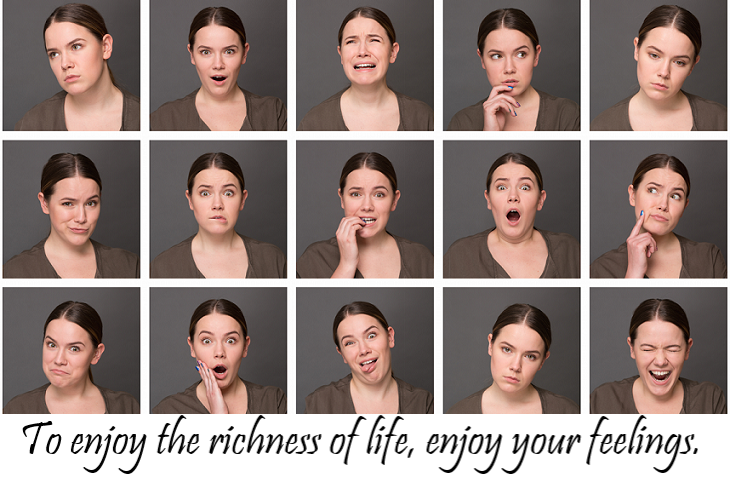Emotions and Feelings: Their Functioning Part (III)
Contents: Introduction, Trusting Our Feelings, Mixed Feelings, Amalgams of Feeling, Compounding Feeling, Hierarchy of Feeling, Conclusion
INTRODUCTION
In the first Letter (April 2020) of this series on emotions and feelings, we defined feeling as a certain kind of energy that we experience in our body and emotions as a combination of feeling and thought. Here we focus on different aspects of feeling before turning our attention to working with emotions, feelings, and thoughts. The usefulness and value of these ideas will become clearer as we put theory into practice, the practice of creating the life we want.
TRUSTING OUR FEELINGS
A question arises: Can we trust our feelings? Is there a place for mistrusting our feelings? We can trust our feelings if we experience the truth of our feelings. A feeling is a “fact”—the “truth” of my experience and an undeniable reality. That I feel angry or happy, for example, is the truth, the reality, of my experience. We should not deny this reality by pretending that the feeling does not exist—by “defending” against it. We will pay a heavy price for our denial because reality impacts us whether we acknowledge it or not. When we honestly feel and face a feeling, without denial we are accepting this truth about ourselves. In addition, if we distort a feeling by pretending that a feeling is something other than what it truly is, our reality and therefore our life, becomes distorted.
The second aspect about the truth of a feeling is the message that a feeling has for us. If we interpret the message accurately, the information we get will be a truth about us. For example, my constant anger at my boss tells me about the deep dissatisfaction I have about my job. Or, the happiness I feel when I spend time with my son/daughter tells me about the love I have for them.
Point Of Empowerment: If we distort our feelings we will mistrust them. If we deny our feelings we will not trust ourselves.
Feelings, along with thoughts, determine what our behavior will be. Before acting on a feeling we may need to evaluate the validity and appropriateness of the feeling with respect to a situation we are facing. This is where “mistrusting” our feelings comes in.
We may have behaved in a certain way and gotten a reaction to that behavior. That reaction was something we wanted or something we did not want. We could repeat the behavior or change it. If we decide to change the behavior we need to know what feeling helped motivate it. For example, in anger I cursed at my child who then felt hurt and started crying. Since I want to stop cursing, I recognize the anger and the angry thought and consider alternative ways of thinking that will generate patience and patient behavior.
Point Of Empowerment: As we observe our unwanted behavior, we can use the feeling that is present to alert us to the fact that our thoughts are not moving us in the direction that we want to go.
Part of trusting our feelings is to understand our agendas, the agendas that we are aware of and the hidden agendas that we are unaware of, the constructive ones and the destructive ones. Agendas create intentions, purpose, and motivations. Our most important constructive agenda is to fulfil our needs, the needs of survival, safe/security, belonging/loving, self-esteem, to create/produce/know, self-actualization, and beauty/mystery/transcendence. We have other agendas such as:
- Proving that I am right and that you are wrong
- Proving a parent right or wrong
- Showing that I am a good husband, father, wife, mother, son, daughter, lover, or employee
- Proving that my beliefs are correct
- Showing that “I am good enough”
- Demonstrating my loyalty to my family and ignoring that this may be self-destructive
- Punishing my parents by failing at all I do
- Denying myself love
- Avoiding pleasure and seeking pain
If we know about and understand our agendas we can keep this knowledge in mind as we think about our feelings. For example: I am compulsively driven by a feeling of anxiety to “try harder”. This anxiety comes from anticipating the pain of never feeling that what I do is good enough, that I am good enough.
Another aspect of learning to trust our feelings is being able to see that a feeling can be either overly intense or not intense enough. These feelings are not effective in helping us deal with situations that we encounter. For example, an overly intense feeling can come from a childhood experience where our parents often silenced us when we expressed ourselves. As an adult an excessively strong feeling of anger arises if someone stifles our self-expression. A feeling that is not strong enough is often caused by a fear of some negative consequence. We may fear being punished for feeling a certain way if we were punished as a child for that feeling. Being punished for anger is a common experience that results in “weak anger,” when “strong,” intense anger is called upon to protect oneself.
Point Of Empowerment: If we commit ourselves to examining our behavior as objectively as possible and to discovering the feelings that are part of the motivation for a behavior, we will be more relaxed about our feelings and be willing to trust them.
MIXED FEELINGS
Having mixed feelings is having more than one feeling at a time. The most common experience of mixed feelings is ambivalence, wanting and not wanting something at the same time. For example, everyone has some ambivalence about love and intimacy, wanting them and not wanting them at the same time. Resolving this ambivalence can be particularly difficult if an experience of trauma contributes to the ambivalence. Other examples of mixed feelings are: feeling angry at my partner and sad that our relationship has so much conflict; feeling hurt by my parent’s neglect and anger at them for hurting me; feeling sad about the death of a loved one and relief that his/her suffering has ended; or experiencing pleasure and pain together, at the same time.
Mixed feelings often result in confusing, contradictory, emotional experiences. Also we can have confusing interactions with others if our mixed feelings are communicated verbally and non-verbally with facial expressions or tones of voice. “I feel furious at what my boss is saying but I present a smiling face to him/her feeling afraid of retaliation if I show my anger. My boss may perceive me as being dishonest.” Or, “I apologize for my hurtful behavior while inwardly feeling happy about what I did. My apology is then perceived as insincere.”
Mixed feelings are a clue to conflicting emotions containing contradictory thoughts. Conflicting emotions produce the pain of inner conflict, which can be intense at times.
Mixed feelings and ambivalence short circuit the power of our actions. Feeling gives power to our emotions and our emotions power our actions. For example, “My request for raise is weak if I doubt the value of my contribution to my company. My feeling of doubt weakens the power of my request.” Often our experience of mixed feelings is the feeling of confusion, confusion about what I feel and confusion about what I should do to deal with a particular situation.
Practice: If you don’t know what to do about something, tune into the feeling of confusion. Follow that confusion toward clarity about your feelings with the affirmation, “I feel confused. I open myself to gaining clarity about what I feel and what I should do.” Relax and allow the clarity to come to you immediately or in the near future.
AMALGAMS OF FEELING
An amalgam is a combination of two or more feelings experienced together. Examples are anxious fun, anxious excitement, curious fear, fearful curiosity, guilty pleasure, or fearful excitement (of a rollercoaster for instance). We experience hateful loving—”right now I hate the person I love” or loving hate—”I love hating this person.” Amalgams are not conflicting feelings with their inner conflict but combinations of feelings occurring together. While they are often some mixture of pleasure and pain, mixed feelings can add richness to life.
COMPOUNDING
Our feelings compound, increasing in intensity, and developing layers. For example, fear of fear develops, possibly followed by fear of the fear of fear. Anxiety about being anxious occurs. We get angry about feeling angry. We can create doubt about doubt which can be a “healthy skepticism” or a painful, never ending confusion. This second layer of emotion can be particularly difficult to work with due to confusion and vagueness. Compounding anxiety is often a component of a phobia. We become anxious about our anxiety and then anxious about being anxious about our anxiety. This kind of runaway anxiety can lead to a panic attack with unbearable anxiety.
HIERARCHY OF FEELING
Let’s look at an aspect of feeling that could seem speculative and not very useful. Its value will be fully demonstrated when we explore techniques for working with emotions and feelings. Here we lay the theoretical groundwork.
We have said that feelings are a certain kind of energy that we feel in our bodies. Energy travels in waves and has what is called a frequency and an amplitude. There are high and low frequencies and high and low amplitudes. The higher the frequency and amplitude, the more energy is contained in a wave. The more energy a wave has the more impact it has, like feeling the shock wave of a big explosion. We can experience the energy of feeling/emotion when someone expresses that emotion toward us. For example, we can feel the impact of someone yelling at us with hatred or feel the wonder and delight of someone telling us that he or she loves us.
As human beings we experience the energy of feeling in a totally subjective manner. Each person’s experience of feeling is unique. However there is a hierarchy of feeling that is demonstrated by the list below. The higher number feelings can potentially contain higher levels of energy, have a greater impact, and feel much better. The list starts with painful feelings and progress upward toward pleasurable feelings.
Point Of Empowerment: The value of this list is to show us what feelings we can aim for as we move from pain toward pleasure, from hopelessness and despair toward love.
- Hopelessness and despair
- Depression, grief, and powerlessness
- Loneliness and worthlessness
- Hatred and rage
- Jealousy and envy
- Hurt and betrayal
- Fear and anxiety
- Anger and resentment
- Pessimism
- Guilt
- Overwhelm
- Worry and doubt
- Frustration and confusion
- Boredom and impatience
Feelings shift here becoming more positive.
- Well-being, contentment, and satisfaction
- Optimism
- Thrill and excitement
- Hope and trust
- Happiness and enthusiasm
- Passion and compassion
- Love and joy
CONCLUSION
We have examined aspects of the complexity of the life of feelings. This can help us appreciate the richness and value of feeling. In the October Letter we will look at working with emotions, feelings, and thoughts, making the theoretical practical.
